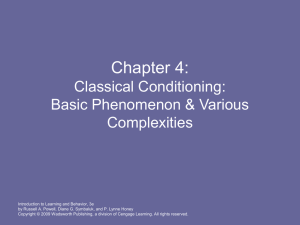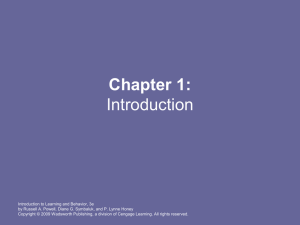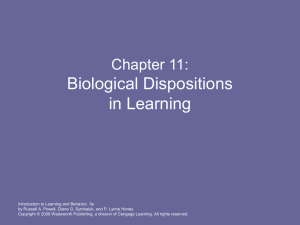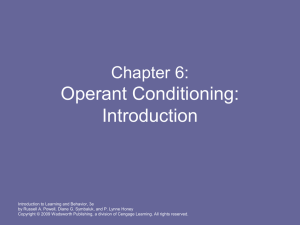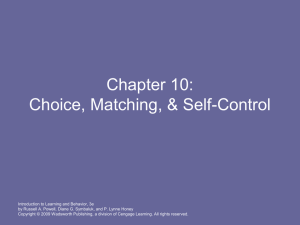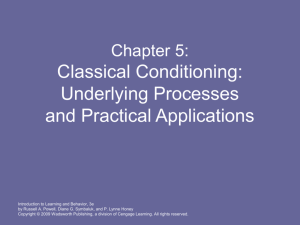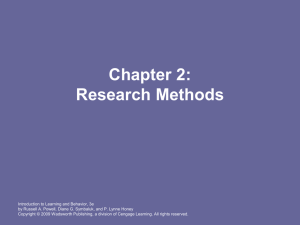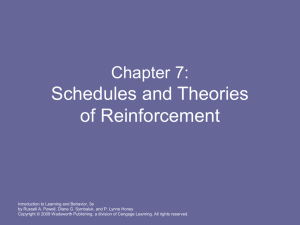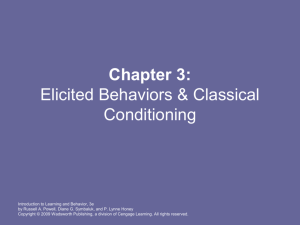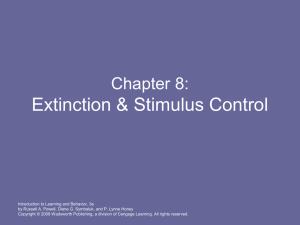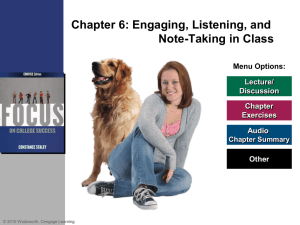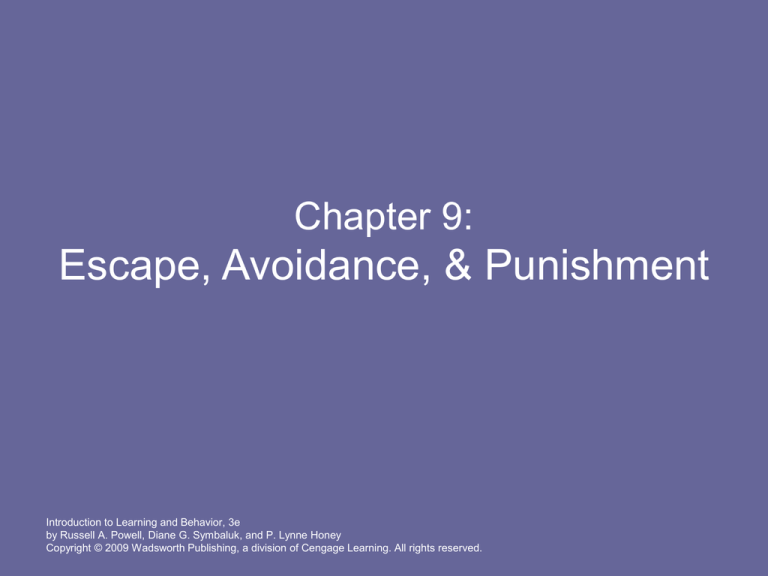
Chapter 9:
Escape, Avoidance, & Punishment
Introduction to Learning and Behavior, 3e
by Russell A. Powell, Diane G. Symbaluk, and P. Lynne Honey
Copyright © 2009 Wadsworth Publishing, a division of Cengage Learning. All rights reserved.
Two Behaviors Are Associated With
Negative reinforcement
1. escape behavior, in which performance of the
behavior terminates the aversive stimulus, and
2. avoidance behavior, in which performance of
the behavior prevents the aversive stimulus
from occurring.
• Examples:
–
–
we run indoors after it has started to rain (escape)
we head indoors before it starts to rain (avoidance)
Introduction to Learning and Behavior, 3e
by Russell A. Powell, Diane G. Symbaluk, and P. Lynne Honey
Copyright © 2009 Wadsworth Publishing, a division of Cengage Learning. All rights reserved.
Shuttle Avoidance Procedure
• an animal has to shuttle back and forth in
a box to avoid an aversive stimulus.
• Example:
– A rat in a chamber must climb over a low
barrier to stop feeling a shock.
• This procedure demonstrates that we first
learn to escape from an aversive stimulus
and then to avoid it.
Introduction to Learning and Behavior, 3e
by Russell A. Powell, Diane G. Symbaluk, and P. Lynne Honey
Copyright © 2009 Wadsworth Publishing, a division of Cengage Learning. All rights reserved.
Notation for Example of a Rat’s
Escape & Avoidance Behavior
• Escape:
Shock: Cross barrier Removal of shock
SD
R
SR
• Avoidance
Light: Cross barrier Avoidance of shock
SD
R
SR
Introduction to Learning and Behavior, 3e
by Russell A. Powell, Diane G. Symbaluk, and P. Lynne Honey
Copyright © 2009 Wadsworth Publishing, a division of Cengage Learning. All rights reserved.
Two-Process Theory of Avoidance
• an early attempt by to explain avoidance
behavior.
• It states that two processes are involved in
learning an avoidance response:
– A classical conditioning process
– An operant conditioning process
Introduction to Learning and Behavior, 3e
by Russell A. Powell, Diane G. Symbaluk, and P. Lynne Honey
Copyright © 2009 Wadsworth Publishing, a division of Cengage Learning. All rights reserved.
Process 1
• classical conditioning of a fear response to
a CS.
• Example:
– Rat in shuttle avoidance procedure
Light: Shock Fear
NS
US
UR
Light Fear
CS
CR
Introduction to Learning and Behavior, 3e
by Russell A. Powell, Diane G. Symbaluk, and P. Lynne Honey
Copyright © 2009 Wadsworth Publishing, a division of Cengage Learning. All rights reserved.
Process 2
• If the CS generates a conditioned fear
response, then moving away from the CS
should result in a reduction of fear.
• Reduction of fear is a negative reinforcer.
• Example:
– Rat in shuttle avoidance procedure
Light: Climb over barrier Reduction in fear
SD
R
SR
Introduction to Learning and Behavior, 3e
by Russell A. Powell, Diane G. Symbaluk, and P. Lynne Honey
Copyright © 2009 Wadsworth Publishing, a division of Cengage Learning. All rights reserved.
Problem 1
• Avoidance responses are often extremely
persistent.
• The two-process theory cannot account for
such persistence.
• Example:
– Dogs continue to jump a barrier to avoid
shock for hundreds of trials even when no
shock is presented.
Introduction to Learning and Behavior, 3e
by Russell A. Powell, Diane G. Symbaluk, and P. Lynne Honey
Copyright © 2009 Wadsworth Publishing, a division of Cengage Learning. All rights reserved.
Response to Problem 1
• The Anxiety Conservation Hypothesis
states that avoidance responses usually
occur so quickly that there is insufficient
exposure to the CS for the conditioned
fear to fully extinguish.
• It turns out that avoidance responses are
not as persistent as sometimes claimed.
Introduction to Learning and Behavior, 3e
by Russell A. Powell, Diane G. Symbaluk, and P. Lynne Honey
Copyright © 2009 Wadsworth Publishing, a division of Cengage Learning. All rights reserved.
Problem 2
• After repeated avoidance trials, animals
appeared to show no evidence of fear but
continued to make the avoidance
response anyway.
• If the animals were no longer afraid of the
CS, how could avoidance of the CS have
been negatively reinforced by a reduction
in fear?
Introduction to Learning and Behavior, 3e
by Russell A. Powell, Diane G. Symbaluk, and P. Lynne Honey
Copyright © 2009 Wadsworth Publishing, a division of Cengage Learning. All rights reserved.
Response to Problem 2
• There may become significantly less
fearful with experience, there is no
evidence that they become completely
nonfearful.
• As long as some fear remains, the
avoidance response continues.
• The fear reduction is still functioning as a
negative reinforcer for the behavior
Introduction to Learning and Behavior, 3e
by Russell A. Powell, Diane G. Symbaluk, and P. Lynne Honey
Copyright © 2009 Wadsworth Publishing, a division of Cengage Learning. All rights reserved.
One-Process Theory
• the act of avoidance is negatively
reinforced simply by the lower rate of
aversive stimulation it is associated with.
• Example:
– A rat persistently climbs over the barrier when
the light comes on because this action results
in a decreased rate of shock and not because
it results in decreased feelings of fear.
Introduction to Learning and Behavior, 3e
by Russell A. Powell, Diane G. Symbaluk, and P. Lynne Honey
Copyright © 2009 Wadsworth Publishing, a division of Cengage Learning. All rights reserved.
Species-Specific Defense
Reaction Theory
• avoidance behaviors are actually elicited
behaviors rather than operant behaviors.
Introduction to Learning and Behavior, 3e
by Russell A. Powell, Diane G. Symbaluk, and P. Lynne Honey
Copyright © 2009 Wadsworth Publishing, a division of Cengage Learning. All rights reserved.
Avoidance Conditioning and
Phobias
• Avoidance learning appears to be a fundamental
process in the development and maintenance of
phobic behavior.
• It is studied using rats, but are rats & humans
really that similar?
– Animals avoid the US, while people avoid the CS.
– The avoidance behavior conditions less readily in
experiments than it does in phobias.
– Experimental avoidance is less than 100% certain.
Introduction to Learning and Behavior, 3e
by Russell A. Powell, Diane G. Symbaluk, and P. Lynne Honey
Copyright © 2009 Wadsworth Publishing, a division of Cengage Learning. All rights reserved.
Experimental Analogue of a
Human Phobia
1. the reliable establishment of a fear
response with only a single, brief pairing
of the CS and US;
2. subsequent avoidance of the CS as well
as the US; and
3. the occurrence of successful avoidance
on 100% of trials.
Introduction to Learning and Behavior, 3e
by Russell A. Powell, Diane G. Symbaluk, and P. Lynne Honey
Copyright © 2009 Wadsworth Publishing, a division of Cengage Learning. All rights reserved.
Stampfl’s (1987) Procedure
• The phobic individual learns to make the
avoidance response early on in the chain
of events so as to minimize the effort of
avoiding.
• Figure 9.2 – image only
Introduction to Learning and Behavior, 3e
by Russell A. Powell, Diane G. Symbaluk, and P. Lynne Honey
Copyright © 2009 Wadsworth Publishing, a division of Cengage Learning. All rights reserved.
Stampfl’s Results
• Rats soon learned to run back to the safe area
immediately after the conveyor belt started up.
• Rather than waiting, they began running back
after traveling only a short distance.
• The rats completely avoided entering the black
compartment on more than 1,000 consecutive
trials.
• The rats consistently avoided the aversive CS
that was associated with shock.
Introduction to Learning and Behavior, 3e
by Russell A. Powell, Diane G. Symbaluk, and P. Lynne Honey
Copyright © 2009 Wadsworth Publishing, a division of Cengage Learning. All rights reserved.
Avoidance Conditioning and
Obsessive-Compulsive Disorder
•
Obsessive-compulsive disorder (OCD) is
a disorder characterized by:
1. persistent thoughts, impulses, or images
(called obsessions), and
2. repetitive, stereotyped actions (called
compulsions)
that are carried out in response to the
obsessions.
Introduction to Learning and Behavior, 3e
by Russell A. Powell, Diane G. Symbaluk, and P. Lynne Honey
Copyright © 2009 Wadsworth Publishing, a division of Cengage Learning. All rights reserved.
Examples
• A person might have an obsessive worry about
contacting germs (obsession)
• This leads to a compulsive tendency to take a
shower and clean the house many times each
day.
• A person might have an obsessive worry about
whether she locked her apartment door when
she left that morning.
• This leads to a compulsive pattern of returning to
the apartment several times a day to check it.
Introduction to Learning and Behavior, 3e
by Russell A. Powell, Diane G. Symbaluk, and P. Lynne Honey
Copyright © 2009 Wadsworth Publishing, a division of Cengage Learning. All rights reserved.
OCD & the Two-Process Theory
• Obsessions and compulsions have
opposite effects on anxiety.
• Obsessions associate with an increase in
anxiety, whereas compulsions associate
with an decrease in anxiety.
• Example:
– A person who has a contamination fear
Introduction to Learning and Behavior, 3e
by Russell A. Powell, Diane G. Symbaluk, and P. Lynne Honey
Copyright © 2009 Wadsworth Publishing, a division of Cengage Learning. All rights reserved.
OCD vs. Phobia
• OCD typically involves an active
avoidance response.
• Phobic behavior typically involves a
passive avoidance response.
• Example:
– A person with OCD will clean often.
– A person with a phobia will avoid dogs.
Introduction to Learning and Behavior, 3e
by Russell A. Powell, Diane G. Symbaluk, and P. Lynne Honey
Copyright © 2009 Wadsworth Publishing, a division of Cengage Learning. All rights reserved.
Exposure and Response
Prevention (ERP)
• a method of treating OCD that involves
prolonged exposure to the anxietyarousing event while not engaging in the
compulsive behavior pattern that reduces
the anxiety.
• It combines the graduated exposure of
systematic desensitization with the
prolonged exposure of flooding therapy.
Introduction to Learning and Behavior, 3e
by Russell A. Powell, Diane G. Symbaluk, and P. Lynne Honey
Copyright © 2009 Wadsworth Publishing, a division of Cengage Learning. All rights reserved.
Example of ERP
• A compulsive cleaner might be required to first
touch door handles and hand rails that cause
low anxiety.
• Then she must touch objects associated with
moderate anxiety, such as garbage cans and
dogs.
• Finally she must touch dead birds and dog
excrement, which are associated with high
anxiety.
• She cannot perform any compulsive behavior
patterns during exposure.
Introduction to Learning and Behavior, 3e
by Russell A. Powell, Diane G. Symbaluk, and P. Lynne Honey
Copyright © 2009 Wadsworth Publishing, a division of Cengage Learning. All rights reserved.
Problems with Explanation of OCD
• People with OCD are usually unable to recall
any particular conditioning event that could
account for the obsessional anxiety response.
• However, selective sensitization and genetic
predisposition may also lead to the development
of OCD.
• People with OCD also have a tendency to feel
personally responsible for events that are highly
improbable.
Introduction to Learning and Behavior, 3e
by Russell A. Powell, Diane G. Symbaluk, and P. Lynne Honey
Copyright © 2009 Wadsworth Publishing, a division of Cengage Learning. All rights reserved.
Punishment
• Remember punishment is
– the weakening of a behavior through the
application of an aversive stimulus or the
removal of an appetitive stimulus.
Introduction to Learning and Behavior, 3e
by Russell A. Powell, Diane G. Symbaluk, and P. Lynne Honey
Copyright © 2009 Wadsworth Publishing, a division of Cengage Learning. All rights reserved.
Positive Punishment
• consists of the presentation of an aversive
event following a response.
• This leads to a decrease in the future
strength of that response.
• Examples:
– Receiving a spanking for swearing
– Being reprimanded for talking back to the
boss
Introduction to Learning and Behavior, 3e
by Russell A. Powell, Diane G. Symbaluk, and P. Lynne Honey
Copyright © 2009 Wadsworth Publishing, a division of Cengage Learning. All rights reserved.
Negative Punishment
• consists of the removal of an appetitive
event following a response.
• This then leads to a decrease in the future
strength of that response.
• Examples:
– A loss of employment for being obnoxious
– A loss of dessert for complaining at the dinner
table
Introduction to Learning and Behavior, 3e
by Russell A. Powell, Diane G. Symbaluk, and P. Lynne Honey
Copyright © 2009 Wadsworth Publishing, a division of Cengage Learning. All rights reserved.
Time-Out
• the loss of access to positive reinforcers for a
brief period of time following the occurrence of a
problem behavior.
• Example:
– Punish a child’s misbehavior by sending her to the
bedroom or by making her sit in a corner for several
minutes.
• It is likely to be ineffective if the time-out setting
is actually more reinforcing.
• Time-outs that are too long interfere with the
development of more appropriate behaviors.
Introduction to Learning and Behavior, 3e
by Russell A. Powell, Diane G. Symbaluk, and P. Lynne Honey
Copyright © 2009 Wadsworth Publishing, a division of Cengage Learning. All rights reserved.
Response Cost
• the removal of a specific reinforcer following the
occurrence of a problem behavior.
• Examples:
– Receiving a fine for speeding
– Taking a child’s toys away for misbehaving
• It is easy to adjust the punishment to suit the
misbehavior.
• You must clearly identify a reinforcer that, if
removed, will have an impact on behavior.
Introduction to Learning and Behavior, 3e
by Russell A. Powell, Diane G. Symbaluk, and P. Lynne Honey
Copyright © 2009 Wadsworth Publishing, a division of Cengage Learning. All rights reserved.
Negative Punishment vs. Extinction
• Does the behavior grows weaker
because performing the behavior
1. no longer leads to something (extinction), or
2. leads to the removal of something that you
would otherwise possess (negative
punishment)?
• Example:
– Jason’s whining and cookies
Introduction to Learning and Behavior, 3e
by Russell A. Powell, Diane G. Symbaluk, and P. Lynne Honey
Copyright © 2009 Wadsworth Publishing, a division of Cengage Learning. All rights reserved.
Intrinsic Punishment
• the activity itself is punishing, such that the
person performing the behavior is now
less likely to repeat it.
• Example:
– Watching an upsetting television show
Introduction to Learning and Behavior, 3e
by Russell A. Powell, Diane G. Symbaluk, and P. Lynne Honey
Copyright © 2009 Wadsworth Publishing, a division of Cengage Learning. All rights reserved.
Extrinsic Punishment
• the activity is followed by a separate event
that serves to punish the activity.
• Example:
– Being chastised after lighting up a cigarette
Introduction to Learning and Behavior, 3e
by Russell A. Powell, Diane G. Symbaluk, and P. Lynne Honey
Copyright © 2009 Wadsworth Publishing, a division of Cengage Learning. All rights reserved.
Primary (or Unconditioned)
Punisher
• an event that is innately punishing.
• We are born to dislike these events.
• Example:
– Shock
– Loud noise
Introduction to Learning and Behavior, 3e
by Russell A. Powell, Diane G. Symbaluk, and P. Lynne Honey
Copyright © 2009 Wadsworth Publishing, a division of Cengage Learning. All rights reserved.
Secondary (or Conditioned)
Punisher
• an event that has become punishing because it
has in the past been associated with some other
punisher.
• Example:
Tone: Shock Fear
NS US
UR
Tone Fear
CS
CR
• Secondary punishers control a lot of human
behavior.
Introduction to Learning and Behavior, 3e
by Russell A. Powell, Diane G. Symbaluk, and P. Lynne Honey
Copyright © 2009 Wadsworth Publishing, a division of Cengage Learning. All rights reserved.
Generalized (or Generalized
Secondary) Punisher
• a special type of secondary punisher,
which is an event that has become
punishing because it has in the past been
associated with many other punishers.
• Example
– An icy stare
Introduction to Learning and Behavior, 3e
by Russell A. Powell, Diane G. Symbaluk, and P. Lynne Honey
Copyright © 2009 Wadsworth Publishing, a division of Cengage Learning. All rights reserved.
Problems with the Use of
Punishment
1. Punishment of an inappropriate behavior
does not directly strengthen the
occurrence of appropriate behavior.
– It may even result in a general suppression
of behavior.
2. The person delivering the punishment
could become an SD for punishment.
– The unwanted behavior is suppressed only
when that person is present.
Introduction to Learning and Behavior, 3e
by Russell A. Powell, Diane G. Symbaluk, and P. Lynne Honey
Copyright © 2009 Wadsworth Publishing, a division of Cengage Learning. All rights reserved.
Problems with the Use of
Punishment, continued
3. Punishment might simply teach the
individual to avoid the person who
delivered the punishment.
4. Punishment is likely to elicit a strong
emotional response.
– This might interfere with any subsequent
attempts to teach appropriate behaviors.
Introduction to Learning and Behavior, 3e
by Russell A. Powell, Diane G. Symbaluk, and P. Lynne Honey
Copyright © 2009 Wadsworth Publishing, a division of Cengage Learning. All rights reserved.
Problems with the Use of
Punishment, continued
5. Punishment can sometimes elicit an
aggressive reaction.
– The aggressive may be directed at the
punisher or another target.
6. The use of punishment might teach the
person that punishment is an acceptable
means of controlling behavior.
Introduction to Learning and Behavior, 3e
by Russell A. Powell, Diane G. Symbaluk, and P. Lynne Honey
Copyright © 2009 Wadsworth Publishing, a division of Cengage Learning. All rights reserved.
Problems with the Use of
Punishment, continued
7. The use of punishment is often strongly
reinforced.
– The punisher may be enticed to punish more
often because she likes the results.
Introduction to Learning and Behavior, 3e
by Russell A. Powell, Diane G. Symbaluk, and P. Lynne Honey
Copyright © 2009 Wadsworth Publishing, a division of Cengage Learning. All rights reserved.
Benefits of Punishment
1. Punishment can sometimes lead to an
increase in social behavior.
• Example:
–
A young child may become more affectionate.
2. Punishment sometimes results in an
improvement in mood.
• Example:
–
A young child may stop crying.
Introduction to Learning and Behavior, 3e
by Russell A. Powell, Diane G. Symbaluk, and P. Lynne Honey
Copyright © 2009 Wadsworth Publishing, a division of Cengage Learning. All rights reserved.
Benefits of Punishment, continued
3. Punishment can increase attention to the
environment.
• Example:
– A young child may show increased eye
contact and interest in ongoing activities.
Introduction to Learning and Behavior, 3e
by Russell A. Powell, Diane G. Symbaluk, and P. Lynne Honey
Copyright © 2009 Wadsworth Publishing, a division of Cengage Learning. All rights reserved.
Effective Use of Punishment
1. Punishment should be immediate rather than
delayed.
–
This aids the association between the punishment
and the unwanted behavior.
2. Punishment should consistently follow each
occurrence of the unwanted behavior.
3. Punishment should be intense enough from
the outset to suppress the target behavior.
–
This can help avoid the use of very intense, abusive
punishment.
Introduction to Learning and Behavior, 3e
by Russell A. Powell, Diane G. Symbaluk, and P. Lynne Honey
Copyright © 2009 Wadsworth Publishing, a division of Cengage Learning. All rights reserved.
Effective Use of Punishment,
continued
• Negative punishment is generally preferable to
positive punishment.
– This is less likely to produce many of the harmful side
effects of punishment.
• Punishment is more effective when
accompanied by an explanation.
– Thus, it easier to avoid punishment in the future.
• Punishment of inappropriate behavior should be
combined with positive reinforcement for
appropriate behavior.
Introduction to Learning and Behavior, 3e
by Russell A. Powell, Diane G. Symbaluk, and P. Lynne Honey
Copyright © 2009 Wadsworth Publishing, a division of Cengage Learning. All rights reserved.
Conditioned Suppression Theory
• punishment does not weaken a behavior but
instead produces an emotional response that
interferes with the occurrence of the behavior.
• Example:
– When the rat is shocked, it becomes too upset to
press the lever.
• Punishment does not directly weaken a
behavior.
• It simply replaces the punished behavior with an
emotional response that interferes.
Introduction to Learning and Behavior, 3e
by Russell A. Powell, Diane G. Symbaluk, and P. Lynne Honey
Copyright © 2009 Wadsworth Publishing, a division of Cengage Learning. All rights reserved.
Avoidance Theory of Punishment
• punishment actually involves a type of
avoidance conditioning in which the avoidance
response consists of any behavior other than the
behavior being punished.
• Example:
– Doing anything other than lever pressing is negatively
reinforced by the absence of the shock.
• Punishment does not directly weaken a
behavior.
• It simply replaces the punished behavior with
another behavior that is reinforced.
Introduction to Learning and Behavior, 3e
by Russell A. Powell, Diane G. Symbaluk, and P. Lynne Honey
Copyright © 2009 Wadsworth Publishing, a division of Cengage Learning. All rights reserved.
The Premack Approach to
Punishment
• a low-probability behavior can be used to
punish a high probability behavior.
• Example:
Running in a wheel (LPB) Eating food (HPB)
R
SR
Eating food (HPB) Running in a wheel (LPB)
R
SP
Introduction to Learning and Behavior, 3e
by Russell A. Powell, Diane G. Symbaluk, and P. Lynne Honey
Copyright © 2009 Wadsworth Publishing, a division of Cengage Learning. All rights reserved.
Learned Helplessness
• a decrement in learning ability that results from
repeated exposure to uncontrollable aversive
events.
• Example:
– Researchers compared the behaviors of dogs in an
inescapable-shock condition with the behaviors of
dogs in an escapable-shock condition.
– The prior exposure to inescapable shock seemed to
impair the dogs’ ability to learn to escape shock when
escape later became possible.
Introduction to Learning and Behavior, 3e
by Russell A. Powell, Diane G. Symbaluk, and P. Lynne Honey
Copyright © 2009 Wadsworth Publishing, a division of Cengage Learning. All rights reserved.
Another Explanation
• Animals exposed to inescapable aversive
stimulation are distressed, and thus have
difficulty attending to the relationship
between a behavior and its outcomes.
Introduction to Learning and Behavior, 3e
by Russell A. Powell, Diane G. Symbaluk, and P. Lynne Honey
Copyright © 2009 Wadsworth Publishing, a division of Cengage Learning. All rights reserved.
Learned Helplessness in Humans
• Children who attempted to answer unsolvable
problems later had considerable difficulty
answering solvable problems.
• “Math-anxious” individuals who quickly give up
when confronted by any sort of math problem.
• People who suffer a series of uncontrollable
aversive events—loss of a job, physical illness,
divorce, and so on—may become extremely
passive and despondent.
Introduction to Learning and Behavior, 3e
by Russell A. Powell, Diane G. Symbaluk, and P. Lynne Honey
Copyright © 2009 Wadsworth Publishing, a division of Cengage Learning. All rights reserved.
Treatments for Learned
Helplessness
• They often involve:
– encouraging the patient to accomplish a
graded series of relatively minor tasks, and
– then progressing to more difficult tasks.
• Example:
– Starting with writing a letter, and
– then seeking a new job.
Introduction to Learning and Behavior, 3e
by Russell A. Powell, Diane G. Symbaluk, and P. Lynne Honey
Copyright © 2009 Wadsworth Publishing, a division of Cengage Learning. All rights reserved.
Prevention of Learned
Helplessness
• A history of successfully overcoming minor
adversities might immunize a person
against depression when the person is
later confronted by more serious
difficulties.
Introduction to Learning and Behavior, 3e
by Russell A. Powell, Diane G. Symbaluk, and P. Lynne Honey
Copyright © 2009 Wadsworth Publishing, a division of Cengage Learning. All rights reserved.
Experimental Neurosis
• experimentally produced disorder in which
animals exposed to unpredictable events
develop neurotic-like symptoms.
• Masserman (1943) found that cats that
experienced unpredictable electric shocks or
blasts of air while eating often developed a
pattern of neurotic-like symptoms.
• The cats also developed phobic responses.
• Many of these symptoms are similar to those
found in posttraumatic stress disorder (PTSD).
Introduction to Learning and Behavior, 3e
by Russell A. Powell, Diane G. Symbaluk, and P. Lynne Honey
Copyright © 2009 Wadsworth Publishing, a division of Cengage Learning. All rights reserved.
PTSD
• a disorder that results from exposure to
unpredictable life-threatening events.
• Symptoms include sleep difficulties,
exaggerated startle response, and
intrusive recollections about the trauma.
• Victims often demonstrate fear and
avoidance of trauma-associated stimuli
(phobias), as well as a general numbing of
responsiveness.
Introduction to Learning and Behavior, 3e
by Russell A. Powell, Diane G. Symbaluk, and P. Lynne Honey
Copyright © 2009 Wadsworth Publishing, a division of Cengage Learning. All rights reserved.
Benefits of Research on
Experimental Neurosis
• Experimental neurosis is therefore proving
to be a useful means for investigating the
development of traumatic symptoms.
• Example:
– We have learned that symptoms of PTSD are
more likely to arise when a person is
unexpectedly attacked in the safety of her
own home.
Introduction to Learning and Behavior, 3e
by Russell A. Powell, Diane G. Symbaluk, and P. Lynne Honey
Copyright © 2009 Wadsworth Publishing, a division of Cengage Learning. All rights reserved.
Summary
• Negative reinforcement plays an important
role in the development of escape and
avoidance behaviors.
• We study escape and avoidance with a
shuttle avoidance procedure.
• The two-process theory of avoidance
involves (1) classical conditioning and (2)
operant conditioning.
Introduction to Learning and Behavior, 3e
by Russell A. Powell, Diane G. Symbaluk, and P. Lynne Honey
Copyright © 2009 Wadsworth Publishing, a division of Cengage Learning. All rights reserved.
Summary, continued
• Other theories of avoidance
– Anxiety Conservation Hypothesis
– One-Process Theory
– Species-Specific Defense Reaction Theory
• Applications of Escape & Avoidance in
People
– Phobias
– OCD
Introduction to Learning and Behavior, 3e
by Russell A. Powell, Diane G. Symbaluk, and P. Lynne Honey
Copyright © 2009 Wadsworth Publishing, a division of Cengage Learning. All rights reserved.
Summary, continued
• Positive punishment involves the
presentation of an aversive stimulus.
• Negative punishment involves the removal
of an appetitive stimulus.
• Time-out vs. response cost
• Intrinsic vs. extrinsic
• Primary vs. secondary & generalized
Introduction to Learning and Behavior, 3e
by Russell A. Powell, Diane G. Symbaluk, and P. Lynne Honey
Copyright © 2009 Wadsworth Publishing, a division of Cengage Learning. All rights reserved.
Summary, continued
•
•
•
•
Problems with punishment
Benefits of punishment
Effective use of punishment
Theories of Punishment
– Conditioned Suppression Theory of
Punishment
– Avoidance Theory of Punishment
– The Premack Principle
Introduction to Learning and Behavior, 3e
by Russell A. Powell, Diane G. Symbaluk, and P. Lynne Honey
Copyright © 2009 Wadsworth Publishing, a division of Cengage Learning. All rights reserved.
Summary, continued
• Learned helplessness is a decrement in
learning ability following exposure to
inescapable aversive stimulation.
• Learned helplessness, experimental
neurosis & PTSD
• Treatment for Learned Helplessness
Introduction to Learning and Behavior, 3e
by Russell A. Powell, Diane G. Symbaluk, and P. Lynne Honey
Copyright © 2009 Wadsworth Publishing, a division of Cengage Learning. All rights reserved.

